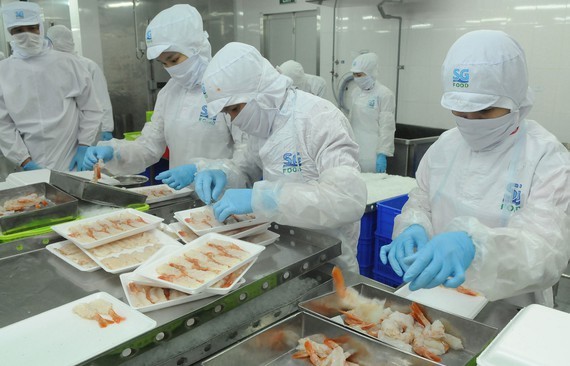
Up to now, the total import-export turnover of agro-forestry-aquatic products was estimated at around US$41.3 billion and the trade surplus was estimated at nearly $10 billion. China was still the largest export market of Vietnam’s food and foodstuff processing industry, accounting for 26.9 percent of total export turnover. The US followed with 21.9 percent, chased after by the EU with 11.7 percent, the ASEAN market with 10.1 percent, Japan with 8.8 percent and South Korea with 5.8 percent.
Ms. Ly Kim Chi, chairwoman of the Food and Foodstuff Association of Ho Chi Minh City, said that the food and foodstuff processing industry has faced many difficulties when exporting to some traditional export markets. Particularly, for the Chinese market, this country promulgated several barriers about quality standards, packing and label specifications for agricultural-aquatic-seafood products imported from Vietnam, causing several Vietnamese exporters to be unable to maintain as well as expand market share at this market.
In fact, in the first six months of this year, the export turnover of agricultural-aquatic-seafood products to China declined by 10.5 percent. Earlier, export turnover also dropped by 5.5 percent in 2018. Amid the context, several enterprises had to reduce export to China and shift to other markets, such as the EU, the US and Russia.
Many enterprises have returned to invest in the domestic market share. Food and foodstuff processing enterprises have been very active in covering goods of traditional distribution channels, as well as carrying out price stabilization policy; hereby building consumer trust, contributing to the stimulation of production to meet the demand of consumers well.
Mr. Nguyen Phuong Dong, deputy director of the Department of Industry and Trade of Ho Chi Minh City, said that in Ho Chi Minh City - where two-thirds of the country's food and food processing enterprises are concentrated, the industrial development index of the food and foodstuff processing industry also recorded a growth of more than 2 percent compared to the same period last year. Of which, the beverage sector strongly grew by 7.38 percent. The proportion of the food and foodstuff processing industry in the whole industrial industry still kept growth of 18.5 percent. With a steady growth rate, the food and foodstuff processing industry has made a significant contribution to the development of four key industrial industries in particular and the city’s industrial industry in general.
According to enterprises, to support enterprises in particular and the food and foodstuff processing industry in general, authorities should promote the reform of administrative procedures, creating a clear corridor for the development of enterprises and increase more trade promotion activities.
The city needs to have policies to build specialized industrial parks for the food and foodstuff processing industry with the scale and area that are suitable for the demand and capacity of enterprises. At the same time, it needs to build material areas through solutions to increase the efficiency of connection between provinces and between farmers and processing enterprises and the management agency. This is a necessary solution for the city to keep enterprises and minimize the situation that enterprises move to neighboring provinces as currently.
As for the market, besides helping enterprises to promote the export advantages of free trade agreements, authorities need to have mechanisms and policies to develop the domestic retail market by supporting retailers, such as Saigon Co.op and Satra, to expand the scale of their current outlets and increase the number of new stores. This is also considered as an indirect solution for domestic enterprises to increase their presence in the market, enhancing their competitiveness against foreign retailers in Vietnam.
Ms. Ly Kim Chi emphasized that the association, as well as enterprises, will actively build a project to standardize quality standards for products of the food and foodstuff processing industry, strengthening domestic brands, increasing product awareness for consumers. Moreover, it will create favorable conditions for authorities to control food and foodstuff products in accordance with regulations.
Another issue that was mentioned by many enterprises is that the Ministry of Health and relevant departments should revise soon the Resolution No.09/2016/ND-CP of the Government about nutrient supplement into food and adjust the time for application of the Circular No.24/2019/TT-BYT of the Ministry of Health on regulations on the management and use of food additives to resolve difficulties for enterprises.
Because of the Resolution No.09/2016/ND-CP, several enterprises have had to build two production lines, including a production line with nutrient supplement to produce products for the domestic market and a production line without nutrient supplement to produce products for export. Regarding the Circular No.24/2019/TT-BYT, it became effective too soon, forcing enterprises to discard the amount of packing that they printed previously, causing significant waste of resources as well as increasing huge expenses for enterprises.
Ms. Ly Kim Chi, chairwoman of the Food and Foodstuff Association of Ho Chi Minh City, said that the food and foodstuff processing industry has faced many difficulties when exporting to some traditional export markets. Particularly, for the Chinese market, this country promulgated several barriers about quality standards, packing and label specifications for agricultural-aquatic-seafood products imported from Vietnam, causing several Vietnamese exporters to be unable to maintain as well as expand market share at this market.
In fact, in the first six months of this year, the export turnover of agricultural-aquatic-seafood products to China declined by 10.5 percent. Earlier, export turnover also dropped by 5.5 percent in 2018. Amid the context, several enterprises had to reduce export to China and shift to other markets, such as the EU, the US and Russia.
Many enterprises have returned to invest in the domestic market share. Food and foodstuff processing enterprises have been very active in covering goods of traditional distribution channels, as well as carrying out price stabilization policy; hereby building consumer trust, contributing to the stimulation of production to meet the demand of consumers well.
Mr. Nguyen Phuong Dong, deputy director of the Department of Industry and Trade of Ho Chi Minh City, said that in Ho Chi Minh City - where two-thirds of the country's food and food processing enterprises are concentrated, the industrial development index of the food and foodstuff processing industry also recorded a growth of more than 2 percent compared to the same period last year. Of which, the beverage sector strongly grew by 7.38 percent. The proportion of the food and foodstuff processing industry in the whole industrial industry still kept growth of 18.5 percent. With a steady growth rate, the food and foodstuff processing industry has made a significant contribution to the development of four key industrial industries in particular and the city’s industrial industry in general.
According to enterprises, to support enterprises in particular and the food and foodstuff processing industry in general, authorities should promote the reform of administrative procedures, creating a clear corridor for the development of enterprises and increase more trade promotion activities.
The city needs to have policies to build specialized industrial parks for the food and foodstuff processing industry with the scale and area that are suitable for the demand and capacity of enterprises. At the same time, it needs to build material areas through solutions to increase the efficiency of connection between provinces and between farmers and processing enterprises and the management agency. This is a necessary solution for the city to keep enterprises and minimize the situation that enterprises move to neighboring provinces as currently.
As for the market, besides helping enterprises to promote the export advantages of free trade agreements, authorities need to have mechanisms and policies to develop the domestic retail market by supporting retailers, such as Saigon Co.op and Satra, to expand the scale of their current outlets and increase the number of new stores. This is also considered as an indirect solution for domestic enterprises to increase their presence in the market, enhancing their competitiveness against foreign retailers in Vietnam.
Ms. Ly Kim Chi emphasized that the association, as well as enterprises, will actively build a project to standardize quality standards for products of the food and foodstuff processing industry, strengthening domestic brands, increasing product awareness for consumers. Moreover, it will create favorable conditions for authorities to control food and foodstuff products in accordance with regulations.
Another issue that was mentioned by many enterprises is that the Ministry of Health and relevant departments should revise soon the Resolution No.09/2016/ND-CP of the Government about nutrient supplement into food and adjust the time for application of the Circular No.24/2019/TT-BYT of the Ministry of Health on regulations on the management and use of food additives to resolve difficulties for enterprises.
Because of the Resolution No.09/2016/ND-CP, several enterprises have had to build two production lines, including a production line with nutrient supplement to produce products for the domestic market and a production line without nutrient supplement to produce products for export. Regarding the Circular No.24/2019/TT-BYT, it became effective too soon, forcing enterprises to discard the amount of packing that they printed previously, causing significant waste of resources as well as increasing huge expenses for enterprises.
























